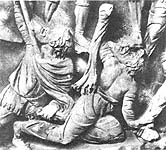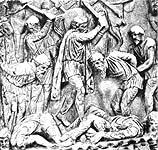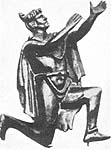 |
||||
|
Lesson #4: Page 2
Iron Age finds from Danish peat bogs would seem to confirm their observations (although it is considered unlikely that the early 'Anglo-Saxons' would have gone naked except for a cloak). The fur cloaks seem to have been worn fur side inwards, skin side outwards and were secured by lacing, sewing, tying, or by securing wooden or leather toggles through loops of leather (i.e. they did not require pins or brooches). Cloth cloaks, short, knee length or longer, were also common. Late Roman representations of Germanic men confirm that textile cloaks of varying lengths were worn. These cloaks were not tailored, but consisted of a square or rectangle of cloth which was clasped at one shoulder, usually the right. Cloaks would be woven in one piece on an upright loom, and often, to begin and end the weaving, tablet woven borders would be used. Similar borders could also be woven in at the sides, thus edging the garment right round. Particularly noteworthy are the large and luxurious cloaks found in the peat bogs of Thorsbjerg, Denmark and Vehenmoor, Germany. Both were of a complex weave and dyed with precious dyes in different colours. The edges of the Thorsbjerg garment were braided on more than one hundred tablets, the Vehenmoor on about one hundred and forty six, and both had elaborate fringes. The Thorsbjerg garment was about 66'' (1.68m) wide and 93'' (2.36m) long, the Vehenmoor 69'' (1.75m) by about 112'' (2.85m). They were worn by folding the material lengthways, and pinning it on the right shoulder. It is very probable that the richest Anglo-Saxons wore voluminous cloaks of this kind; less luxurious versions would also have been common. They are versatile and practical since unpinning and unfolding them turns them into blankets. A large square cloak can also be worn to form a hood by folding approximately the top third over away from the body and then pinning it at the center front. The fold can then be pulled up over the head to form a hood. Cloaks could have been made water resistant by not washing the lanolin out of the woollen yarn before weaving. Although not completely waterproof this would make the garment resistant to light rain. #1 Later evidence suggests leather cloaks (presumably oiled) could be worn in bad weather, but it is not known if they were worn this early. The evidence from textile remains in graves suggests that cloaks were generally of a slightly heavier (and sometimes coarser) weave than the tunic and trousers, and were of wool. A different type of cloak in use by the Germanic peoples was a poncho type garment with a central hole for the head. There are no representations of a man's poncho in Anglo-Saxon art (although some women in late Anglo-Saxon England seem to have worn a poncho like garment) and no direct evidence it was worn in Anglo-Saxon England, but it is certainly a type of garment that might be known, if uncommon. Another type of outer garment possibly worn by the early Germanic settlers is the hooded robe, known to modern scholars as the 'Gallic coat'. It seems likely that cloaks could be made from skin or textile and could vary in size from small capes to large voluminous cloaks of the Thorsbjerg/Vehenmoor type. It is unclear exactly how men fastened their cloaks as there are no brooches known from male graves in England or on the continent during the early Anglo-Saxon period. #2 Brooches are also absent from the few pictorial sources we have. Tacitus mentions a 'thorn' being used and still to this day, the word thorn is still used in Germany to mean pin. There are a number of bone pins known from settlement sites and male graves, the latter often in a position where they could have fastened a cloak. Occasionally simple iron pins are also found which may have served the same function, and perhaps even wooden pins may have been used for the purpose. There are many Old English words for these outer garments - both sexes could wear the hacele (a cloak which might be hooded), the mentel and the sciccels (which could be made of fur). Men wore the fur crusene and heden (which could be hooded) and the rocc (which could be made of fur or skin). The ofer-slop was worn by men, so was the loþa (which could be made of shaggy fabric and used as a coverlet as well as a cloak). There is no evidence to which sex wore the rift (a cloak or curtain) and the sciccing. Click on image for a larger version in a new window 1 Another way of using the lanolin in raw fleece was to make a piled fabric where tufts of raw fleece were worked into the fabric during weaving. This gives the cloak a shaggy appearance on one side, but a normal woven look on the other. This type of cloth is known from some male burials, but it is unclear if this type of cloak was also used by women.back 2 In the late Roman period Germanic soldiers in the Roman Army fastened their cloaks with a 'crossbow brooch'. This type of brooch is well known from pictorial and archaeological sources, and appears to have signified a military man. However, there is no evidence for the use of brooches outside the Roman military. back Page
1 | Page 2 | Page 3 | Page
4 | Page 5 | Page
6 | Page 7 | Page
8
|
||||
| Costume
Classroom is a division of The
Costume Gallery, copyright 1997-2002.
Having problems with this webpage contact: questions@costumegallery.com |



